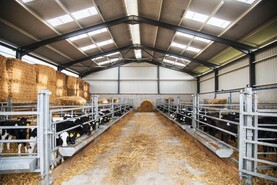Moore Concrete is developing new materials to reduce the carbon footprint of its pre-cast concrete products.
“The problem with concrete is that cement production is responsible for 8% of the world’s carbon dioxide emissions, so we can feel the spotlight on ourselves,” said Adeline McCartney from the Ballymena-based firm.
Speaking to the Guild of Agricultural Journalists on Tuesday, McCartney explained that 1t of standard cement results in 900kg of carbon dioxide emissions.
However, a byproduct from steel manufacturing, known as GGBS, can be used to replace some of the cement content in concrete. Every tonne of GGBS is attributed to only 100kg of carbon dioxide.
“The industry has been using it for a while, although not at the level that we are now being asked for. Something fairly standard would be 40%, but now we are looking at 65% or even up to 80% replacement,” McCartney said.
The downside of GGBS is that it takes longer for the precast product to fully set, which slows up the manufacturing process.
Research
Moore Concrete is currently undertaking a three-year research project with Queens University Belfast which is looking at faster ways of producing precast products with high levels of GGBS. “Hopefully we will get the golden egg at the end where we get green concrete which can be made efficiently,” McCartney said.
One example coming forward is a completely cement-free bunker wall which is made from GGBS and a coal industry byproduct known as pulverised fuel ash.
McCartney said the bunker has a carbon footprint which is four times lower than a conventional cement-based product, although the mix costs twice as much.
“The final product won’t be double the cost as the concrete mix isn’t responsible for all costs associated with the product, but it is significant,” she acknowledged.






 This is a subscriber-only article
This is a subscriber-only article










SHARING OPTIONS: